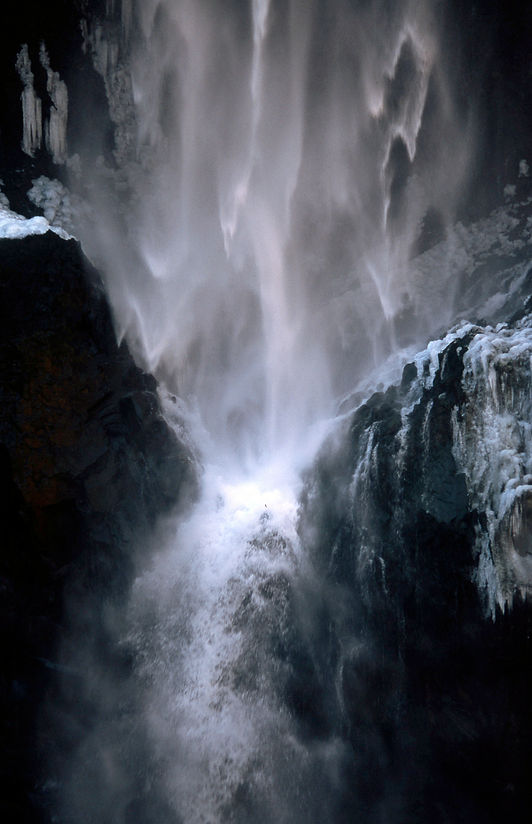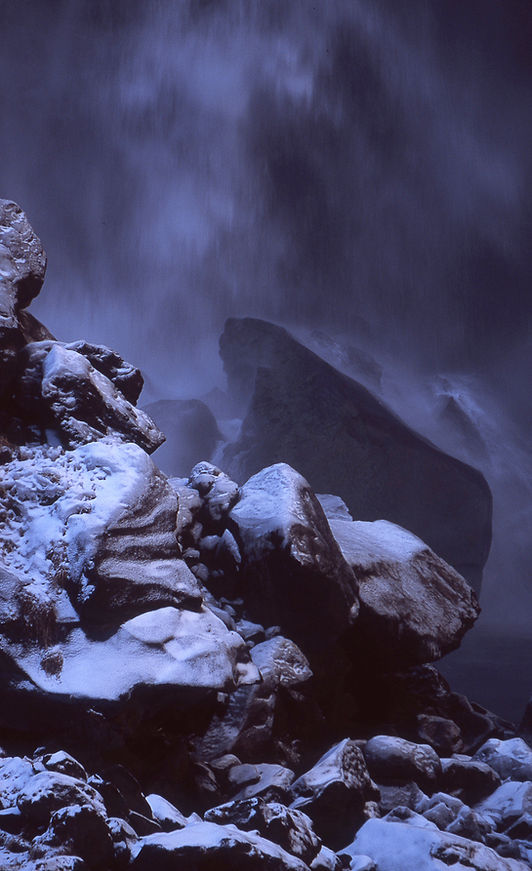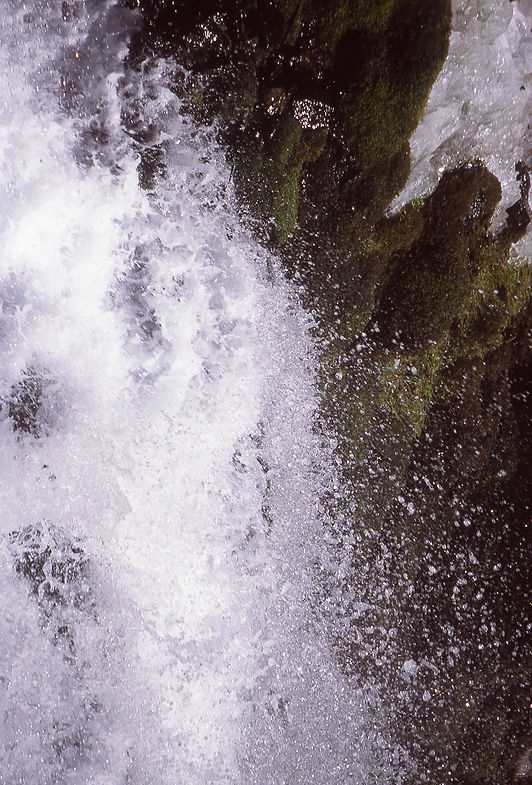KYOTO SCHOOL
2 channel slide projection, Variable size and length, 2017

Installation view, 2 or 3 Tigers, Haus der Kulturen der Welt, Berlin
This work is for two-channel photo slide projections. On one channel, the images of Kegon waterfall will be repeatedly projected, and on the other channel, the montage with texts extracted from writings of Kyoto School, diaries of Kamikaze student pilots mostly about their influenced philosophies and books they beloved. This work, not only is a story about specific historical events, but also is to create discurssive space for thoughts[1] about ‘philosophical image’ and ‘desperate writing’, Nationalism and Cosmopolitanism.
Memo on Kyoto School [2]
On November 26 1941, two weeks before the Japanese attack on Pearl Harbour, there was a roundtable titled ‘The Standpoint of World History and Japan’ organized by magazine. In this roundtable, a group of scholars named as Kyoto School was participated, and they mentioned about ‘Kegon waterfall’ situated in the city of Nikko, Tochigi prefecture in Japan as a political and philosophical image. This waterfall has known for suicide location since the death of Fujimura Misao who killed himself in the age of 18 in 1903. The following is extracts about the waterfall from the dialogue in the roundtable.
“The Standpoint of World History and Japan”
Koyama : Doesn’t the structure of the Kegon universe, with its concept of harmony between the individual and the totality, of the one in the all, of all in the one, offer an effective expression of the individual consciousness of the Nara period? (…)
(……)
Kosaka : (…) While the worlds of East and West are cracking(under the weight of change), while historicism remains trapped in its obstructed path, the absolute foundation that lies behind such a new force is beginning to show itself. I think that this deeper foundation, in all its newness, should be called ‘absolute nothingness’. (…)
Nishitani : This is what contemporary philosophers has to do. But I might add that I think that it is good thing that our own philosophers have a Kegon dimension, that is a Kegon waterfall dimension…
Suzuki : What? Kegon What?
Nishitani : Yes, Kegonist. Not the Kegon sutras. My Kegon is more like the waterfall. (All laugh.)
Kosaka : That’s right. Without something like that, philosophy will never be authentic(hon-mono). It will fall short of true seriousness.
Koyama : Hmm. More like the Kegon Waterfall. Thinking about ways to join the individual and the absolute, it would be better if the content of the historical world came to resemble that Kegon Waterfall. Yes, it would be a good thing if we could leap from the highest rock of the Japanese sprit into that Kegon Waterfall, taking world history with us.
(English translation and quotations from , David Willams, Routledge, 2014)
The waterfall as a specific location is conceptually expanded to the image of Kegon[3] that is radiant and grandeur due to the name itself. The Kegon waterfall is also used as an image for evoking and overlapping meanings such as sublime, determination, sacrifice, absolute, Asian, Japanese spirit and Buddhism. After the roundtable, scholars of Kyoto School gradually celebrate the Pacific War[4] and justifies the war of aggression. Thousands of young student pilots applied to Kamikaze[5], the special forces, and number of the student soldiers were influenced by the Tokyo School in both direct and indirect ways.
The metaphor of Kegon waterfall as a verbal event and the Kamikaze as a real event share a concurrent war images at the time, such as falling down, death wish and it’s instaneousness. The shared image is about unifying the world and individuals throughout making decision of death by jumping themselves into the typhoon and whirlpool of giant history. But this can not be interpreted as just visually condensed Romatic images of the Japanese Militarism, as we can’t simply say that the students were mobilized by the instigation of Kyoto School. There were varied reasons and motivations for students to apply to Kamikaze. It is also known that many students actually criticized about Japanese totalitarianism and its war logic.
The romantic image of sacrifice is actually combined to the ‘meconnaissance’[6] about Japanese Imperialism and war. The sea of typhoon, or ‘Kegon waterfall’ is actually the sea of meconnaissance. The Kamikaze soldiers who are easily recognized as the incarnation of Japanese Nationalism serving Japanese Emperor, shows the universe of thoughts based on cosmopolitan perspective of the period as we can find from their remained diaries. The Kyoto School’s celebration upon the Pacific War is based on the self-meconnaissance of Japanism or Asianism what is known of ‘transcendent of modern’ or planning of very conceptual ‘count western’ idea isolated from the war in reality.
For anyone who has travelled to Kyoto, the city is not a relevant place to imagine about war. Walking along the ‘Philosopher’s Road’[7] from Kyoto University to Ginkaku-ji Temple, we can see the panoramic landscape of the city where could be disappeared like dust by atomic bomb. (Kyoto was one of candidate cities of America's atomic bomb during the war period.) It may be possible to imagine the image of Kegon waterfall and this naïve war time Romanticism only in this peaceful city, Kyoto. (Park Chan-kyong)
[1] Hwadu was a beloved term by Kyoto School based in Zen idea
[2] is also the title of my work.
[3] Kegon (華厳宗) is the Japanese transmission of the Huayan school of Chinese Buddhism.
[4] Japanese call it the Great East Asia War
[5] Kamikaze is literally translated to Spirit Wind
[6] misrecognition, mis-reading, mis-communication
[7] The course is commercially branded as ‘the road of philosopher’
2017 2 or 3 Tigers, Haus der Kulturen der Welt, Berlin





